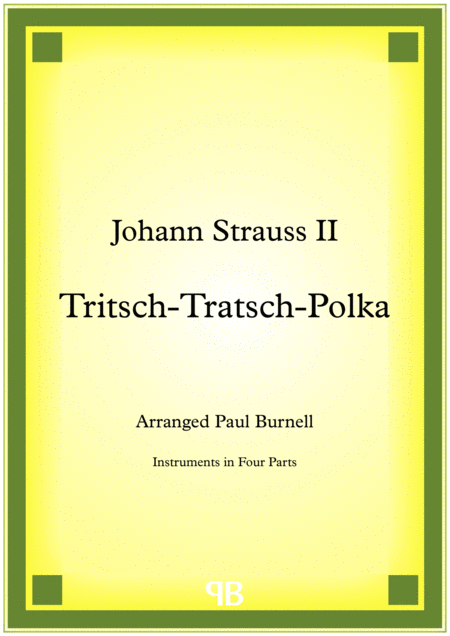Small Ensemble - Level 4 - Digital Download SKU: A0.835859 Composed by Johann Strauss Jr. Arranged by Paul Burnell. Romantic Period. Score and parts. 46 pages. Paul Burnell #5853603. Published by Paul Burnell (A0.835859). Tritsch-Tratsch-Polka, Op. 214, Johann Strauss II (1825 - 1899) arranged by Paul Burnell for instruments in four parts.Download comprises both score and parts.Duration 2:40 Score in CThe arrangement is suitable for multiple quartet combinations with parts available (and potential instrumentations suggested) as follows:Part 1: C, Eb (flute, oboe, alto recorder, Eb clarinet, violin 1)Part 2: C, Bb (oboe, tenor recorder, Bb clarinet, violin 2)Part 3: C - alto & bass clefs, Bb, Eb, F (Bb clarinet, bass recorder, alto saxophone, horn in F, viola)Part 4: C - bass clef, Bb, F (bassoon, great bass recorder, tenor saxophone, horn in F, 'cello)Part 4 may be played an octave lower than written.Any other appropriate instruments, even if not suggested above, may play.Although the score is presented with a layout appropriate for string quartet this does not indicate a preferred instrumentation. This arrangement is transposed from the original key.Programme note:Tritsch-Tratsch-Polka was composed by Johann Strauss II and first performed in Vienna on 24 November 1858.'Tritsch-Tratsch' (chit-chat) refers to the Viennese enthusiasm for gossip. Strauss may also have been referencing the burlesque 'Der Tritschtratsch' by the Austrian playwright and actor Johann Nestroy, which premiered in 1833 and was still in the stage repertoire when the polka was written.
